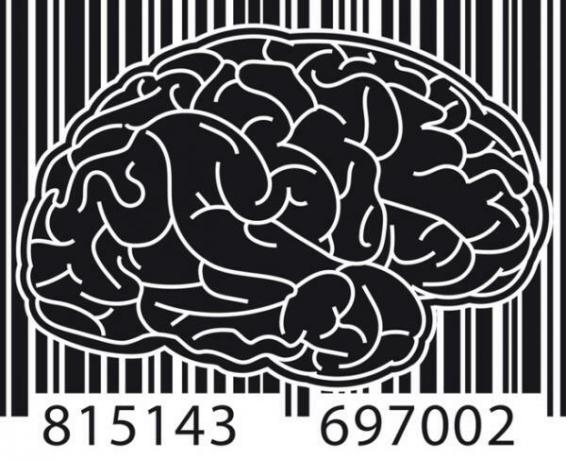
Certain characteristics of the products generate positive emotions and feelings that predispose us to buy. Emotions influence us quickly, before reason comes into play, the decision is made: I'll take it! Certain colors, pleasant scents, and even the music that plays in clothing stores. Stimuli designed to evoke sensations that lead to the optimal state of mind to consume.
In this Psychology-Online article, we tell you all about the neuromarketing: what is it, types and examples.
Index
- What is neuromarketing
- Psychomarketing
- Types of neuromarketing and examples
What is neuromarketing.
What is neuromarketing? Neuromarketing, also called neural marketing, consists of applying the findings of neuroscience to marketing. The definition of neuromarketing is the study of aspects such as emotions, feelings, attention and memory and their influence on consumer behavior. The objectives of neuromarketing are to study how the consumer feels, thinks and acts. From the brain's reaction to advertising stimuli, to the decision-making processes by the consumer. Among the advantages of neuromarketing is the possibility of anticipating the acceptance of a product or enhancing its sales.
Neuromarketing techniques
Neuromarketing techniques seek to know the psychophysiological response after certain stimuli. The main ones are:
- The functional magnetic resonance (fMRI), since it allows to accurately visualize the activation and localization of brain activity against the presented stimuli.
- The electroencephalogram, it also allows to detect the areas of the brain activated through the activity of the brain waves. It is one of the most used neuromarketing techniques since its cost is lower.
- The eye tracking or eye-traking, which consists of detecting the movements of the eyes to determine the visual path made and the reaction presented when observing a stimulus, thus discovering what captures the attention.
Neuromarketing strategies
Some of the strategies that neuromarketing uses are:
- Market studies: the participation of neuromarketing in market studies consists of carefully studying the group of users a product is aimed at, also called the target audience or audience Diana.
- Design and packaging: try to ensure that the characteristics of the product and the packaging influence the consumer experience in the desired way.
- Prices: price characteristics influence the purchasing process. One of the most used neuromarketing strategies regarding prices is the presentation of fractional prices, that is, without round numbers, like the typical 9.99. Generating the feeling that the price is lower. Neuromarketing postulates that not only the numbers influence but also the position and presentation of the price. For example, when the price is the first thing that is shown of the product, the consumer decides based on whether or not it is worth it, while If the price is known after all other characteristics of the product, the purchase is decided based on whether the product likes it. enough.
- Store layout: the arrangement of the products in the space influences the purchase. One of the strategies consists of placing basic necessities at the end of the aisles, forcing the consumer to walk through the space.
- The experience: the emotional state influences the criteria applied to choose a brand, service or product. For example, use the Promotional gifts It is a strategy that encourages the brand or service to be remembered better and more positively.
Neuromarketing books
If the previous explanation has piqued your interest, you can go deeper with one of these neuromarketing books:
- Think Fast, Think Slow (Daniel Kahneman).
- BrainFluence (Roger Dooley).
- Buyology (Martin Lindstrom).
- Do you buy with your heart or with your brain? (Alexia de la Morena and Francisco Misiego).
- The traps of desire. How to control the irrational impulses that lead us to error (Dan Ariely).

Psychomarketing.
The psychomarketing or shopping psychology unites marketing and psychology in a discipline that studies the psychological components involved in the consumption process. A psychomarketing strategy consists of apply the reciprocity law to sell more. It is about doing a favor to the consumer so that he has the motivation to return it. For example, offering you a free first service.
Another strategy used is the psychology of color in marketing and advertising. The color psychology postulates that each color produces an emotion or is associated with a feeling. This is used in marketing by providing a product with the color associated with emotion or characteristic that is intended to express. For example, we can see that the color red, associated with strength, passion and danger, has been used for the Ferrari car brand. While the color yellow, associated with joy, happiness and energy, has been chosen for the Nesquik brand products.
The difference between neuromarketing and psychomarketing is fuzzy. Another overlapping term is emotional marketing, which seems to focus primarily on emotions, while psychomarketing encompasses other psychological aspects.
Types of neuromarketing and examples.
The 3 main types of neuromarketing They start from the classification according to the senses through which they are perceived:
Visual neuromarketing
Visual marketing is one that uses strategies that are captured through sight. It is very effective as the images reach the brain quickly.
- For example, you will have a better chance of selling if you are placed in the center, together with a lower-priced option on the left, and a higher-priced option on the other side, since there is a tendency to choose the average price, neither the most expensive nor the cheapest. Another example is very large shopping carts, which make it appear that less quantity is being carried and allow them to be filled.
Auditory neuromarketing
Auditory marketing is one that uses strategies that are perceived by the ear. Melodies are especially used to recognize a brand. In addition, music influences the mood and therefore the purchase decision.
- For example, when an ad includes the sound of a cookie that creaks when bitten.
Kinesthetic neuromarketing
Stimuli captured by touch, smell or taste can also influence the buying process.
- For example, him characteristic smell of fresh bread, or the smell of an appetizing food stimulates the feeling of hunger, leading to buy food.
This article is merely informative, in Psychology-Online we do not have the power to make a diagnosis or recommend a treatment. We invite you to go to a psychologist to treat your particular case.
If you want to read more articles similar to Neuromarketing: what is it, types and examples, we recommend that you enter our category of Social psychology.
Bibliography
- Álvarez, G., Mazzitelli, A., & Tristezza, D. (2010). Neuromarketing. Creation and Production in Design and Communication, 65.
- From Andreis, A. (2012). Neuromarketing: a look at the mind of the consumer. ADGNOSIS Magazine, 1 (1).
- Nuván, H., & Etefanía, L. Incidence of neuromarketing in purchasing decisions in final consumers.


